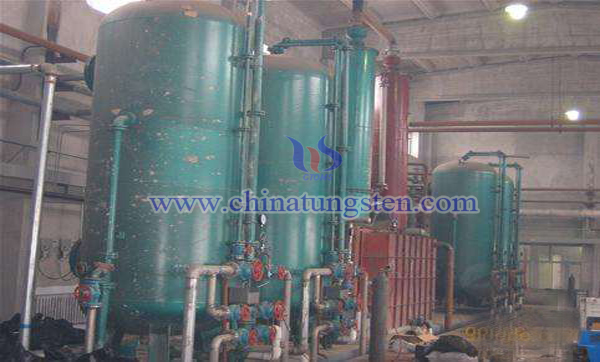Guidelines for Ion Exchange Tin Removal
- Details
- Category: Tungsten Information
- Published on Saturday, 23 March 2019 22:39
In the process of producing ammonium paratungstate by ion exchange, SnO32-and SnS32- are two forms of tin in the leaching solution before ion exchange. Among them, SnS32- has much greater affinity with resin than WO42- and is preferentially adsorbed by resin in ion exchange. When tungsten is desorbed, it will be desorbed with tungsten, and tin is difficult to be removed. Therefore, the leaching of SnS32- in the original solution before ion exchange, even in a small amount, often becomes an important reason for APT tin exceeding the standard.

How to remove the influence of SnS32- At present, the main way to eliminate the hazards of SnS32- is to oxidize tungsten concentrate by pre-roasting, so that the tin ore (Cu2FeSnS4) existing in tungsten concentrate can be oxidized to SnO 2, and the volatilization of S can be removed, thus avoiding the formation of SnS32- in alkali leaching process. However, this method consumes a lot of energy, has a high process growth and cost, so it is necessary to change our thinking and explore a new method. To remove the effect of SnS32-.
For this reason, some researchers adopt one-step hyperbaric oxygen leaching method to oxidize SnS32- to SnO32- by oxygen at the same time in the leaching process, and the S2- in the alkali leaching solution is also oxidized to SO42-at the same time, which can avoid the re-generation of SnS32-and thus achieve the elimination of SnS32-, so that the final product APT meets the standard. The operation process is as follows:
The main components of high tin tungsten concentrate (%): WO3 46.26; Sn 3.57. The leaching residue is extracted and washed in a high-pressure autoclave for 2.5 hours at the conditions of 200 g industrial sodium hydroxide with a liquid-solid ratio of 1.5:1.0, temperature 150 C and oxygen content of 0.3 mpa, which is 2.5 times the theoretical amount. In addition, 200 g of SnS32- in the two alkali leaching solutions was analyzed by high-pressure alkali leaching and liquid-solid separation under the same conditions without oxygen. The content of SnS32- in alkali leaching solution under certain oxygen partial pressure is only 0.22% of the total tin content. SnS32-in the alkali leaching solution without oxygen leaching accounted for 19.48% of the total tin.
By leaching tin from high-tin tungsten concentrate with high-pressure oxygen, the proportion of SnS32- in total tin in sodium tungstate pretreatment solution can be reduced to less than 0.45%. SnO32- exists basically in the form of SnO32- in order to reduce the adsorption of ion exchange resin on tin and achieve the purpose of tin-tungsten separation. The process control is easier, the production process is reduced, and the production cost is reduced. It has practical application value.
- Tungsten Oxide Manufacturer & Supplier, Chinatungsten Online: www.tungsten-oxide.com
- Tungsten News & Prices of China Tungsten Industry Association: www.ctia.com.cn
- Molybdenum News & Price: news.molybdenum.com.cn
- Tel.: 86 592 5129696; Fax: 86 592 5129797; Email: sales@chinatungsten.com



 sales@chinatungsten.com
sales@chinatungsten.com